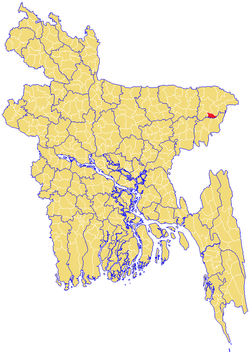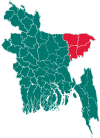Fenchuganj Upazila
Fenchuganj (Bengali: ফেঞ্চুগঞ্জ) is an Upazila of Sylhet District in the Division of Sylhet, Bangladesh.[1]
Fenchuganj ফেঞ্চুগঞ্জ | |
|---|---|
Upazila | |
 | |
| Country | |
| Division | Sylhet Division |
| District | Sylhet District |
| Government | |
| • MP (Sylhet-3) | Mahmud Us Samad Chowdhury |
| • Chairman (Upazila Parishad) | Saifullah Al Hussain |
| Area | |
| • Total | 114.48 km2 (44.20 sq mi) |
| Population | |
| • Total | 138,881 |
| • Density | 1,200/km2 (3,100/sq mi) |
| Demonym(s) | Fenchuganji, Fenchugonji, Fenchigoinji, Fesugoinji, Fesigoinzi |
| Time zone | UTC+6 (BST) |
| Postal code | 3116, 3117 |
| Website | https://www.fenchuganj.sylhet.gov.bd/ |
Etymology
The name Fenchuganj is either derived from the Bengali word pencha meaning 'owl' or the Assamese word fenchu meaning 'Black drongo'. The Bengali word of Persian origin, ganj, means 'marketplace' or 'neighbourhood'.[2] There are many theories behind the naming of the upazila. Some say that Fenchuganj is named after Penchu (or Fenchui) Shah, a guardian of Shah Malum's dargah, who had a habit of sitting at the ghat of the Kushiyara River during the evening everyday. One day, he decided to open up a shop in the ghat, which eventually expanded into Fenchuganj or Fenchu's neighbourhood.[3]
History
After the Conquest of Gour in 1303, some disciples of Shah Jalal migrated and settled in present-day Fenchuganj where they preached Islam to the local people. Shah Malum and Shah Mohabbat migrated to Mahurapur/Mourapur.
In 1907, the Fenchuganj thana was established. Before 1907, it was a part of the Balaganj Thana. During the 1950 East Pakistan riots, the factory of a steamer company was looted and set on fire. Pulin De was murdered near Ilashpur. In Maijgaon, under Fenchuganj police station, the houses of Ambika Kabiraj and Makhan Sen were looted and set on fire.[4]
During the Bangladesh Liberation War, The Pakistani army shot two gardeners at the gate of the Fenchuganj Fertiliser Factory in May 1971. The army then proceeded to the Manipuri Tea Garden, killing another two tea labourers. Kaiyer Warehouse is recognised as a mass killing site during the war and the Ghilachhora Monument stands out to commemorate the tragedies of the war. In 1980, Fenchuganj Thana was upgraded to an upazila.[1]
Geography
Fenchuganj is located at 24.7083°N 91.9403°E . It has 13368 households and total area 114.48 km².
Demographics
As of the 2011 Bangladesh census, Fenchuganj has a population of 138,881 . Males constitute 51.07% of the population, and females 48.93%. This Upazila's eighteen up population is 65383. Fenchuganj has an average literacy rate of 68.5% (7+ years), and the national average of 62.4% literate. Now 91,400 Male are 45,040, and Females are 46,369.[5] Religions: Muslim 88.72%, Hindu 11.25%, Buddhist and Christian 0.03%.
Economy
Fenchuganj Upazila has seven power plants, two urea fertilizer factories, three tea gardens, three rubber gardens, one gas field, Hakaluki Haor (largest Haour in South Asia) and many more.
Farms and industries
| Number | Details | Total |
|---|---|---|
| 1 | Fertiliser Factory | 02 |
| 2 | Power Plants | 06 |
| 3 | Gas Field | 01 |
| 4 | Tea Garden | 02 |
| 5 | Rubber Garden | 03 |
| 6 | Poultries Fishery | 30 |
| 7 | Dairy | 18 |
| 8 | Poultry | 28 |
- Fertiliser Factories are
- Natural Gas Fertiliser Factory Ltd.
(First fertilizer factory planted in Asia) (Producer : Ammonia, Ammonium sulphate, Urea.)
- Shahjalal Fertiliser Factory Ltd
(The biggest fertiliser factory planted in Bangladesh )
- Power Plants are
- Fenchuganj Combined Cycle Gas (170 MW)
- Barakatullah Electro Dynamics Limited (51 MW)
- Energy prima Ltd ( 50 MW)
- Liberty Power US (60 MW)
- Kushiara Power Plant Fenchuganj (50 MW)
- Build Own Opora (BOO) 170 MW
- Tea gardens are
- Monipur Tea Garden
- Muminchara Tea Garden
- Gas field
- Fenchuganj Gas Field
Administration
Fenchuganj has 5 Union Parishads, 45 Wards, 30 Mauza/Mahalla and 114 villages.
- Fenchuganj Union Parishad
- Ward 1: Monur Tok, Fenchuganj Paschim Bazar, Fenchuganj Purba Bazar
- Ward 2: West Islampur, East Islampur, Kazi Bari
- Ward 3: West Rajonpur, East Rajonpur
- Ward 4: Pathan Tila, Mughalpur, KM Tila
- Ward 5: Nij Chattish, Naya Tila, Tafadar Tila, Golaghat
- Ward 6: Southeast Chattish Para
- Ward 7: South Chattish Para, Eastern Chattish Para
- Ward 8: Baghmara, West Pitaitikor
- Ward 9: East Pitaitikor
- Maijgoan Union Parishad
- Ghilachhora Union Parishad
- Manipur Cha, Mourapur, Mominchhora, Daluchhora, Ashighor, Nij Ghilachhora, Mirzapur
- Judhishtipur, Badedeuli, Dharon, Ghazipur, Borobari, Kurbanpur, Jayfarabad
- Uttar Kushiara Union Parishad
- Donaram, Rokonpur, Noyagaon, Narayanpur, Chanpur, Ilashpur, Salehpur, Purbakandi, Gazipur
- Khilpara, Dinpur, Aatghor, Konapara, Kotalpur, Dondi, Majhpara, Muhidpur, Terakuri, Fokirpara
- Uttar Fenchuganj Union Parishad
- Ward 1: Mollikpur
- Ward 2: Kutubpur
- Ward 3: Lamagangapur, Sultanpur, South Manikkona
- Ward 4: Gangapur
- Ward 5: Goyashipur
- Ward 6: Ujangangapur
- Ward 7: West Manikkona-1, West Manikkona-2
- Ward 8: Khatkhal, Valekona
- Ward 9: East Manikkona, Shurikandi, Shailkandi
Transport

Fenchuganj has good communication with the rest of the country because it has river, road and rail links. During British rule river and rail travel were popular, following that roads became more used, and more currently the A2( Asian Highway) road built through Fenchuganj, connecting Sylhet-Dhaka and other parts of the country. Established there is a market place on the bank of River Kushiara, with Tuesday and Saturday being the main trading days. People from the surrounding 10–15 miles come to the market to trade and shop. Now there are many local markets which sit every day. Among the views from Fenchuganj are both bridges over Kushiara. Hills around degree college, lake near degree college, fertiliser factory from nearby hill (jola tilla), tea estates, Delwar Hussain mosque, sunset from ilashpur (dhala) bridge and boat trip down the river are very enjoyable.
Education
Fenchugonj Upazila is performing 5.6% above the Bangladesh national average in education. The average rate of education is 68% in Fenchuganj. There are many educational institutions some of these are,
Education
| Number | Details | Total |
|---|---|---|
| 1 | Mosques | 131 |
| 2 | High Schools | 1 |
| 3 | Junior high school | 02 |
| 4 | Colleges | 04 |
| 5 | Primary School (government) | 36 |
| 6 | Primary School (Private) | 05 |
| 7 | Madrasah (Alia) | 02 |
| 8 | Madrasah (Dakhil) | 04 |
| 9 | Qaumi Madrasah | 18 |
| 10 | Kindergarten school | 09 |
| 11 | Business Management College | 1 |
| 13 | Girls Schools | 02 |
| 14 | Boys schools | 01 |
- Colleges are
- Fenchuganj Degree College
- Fenchuganj Business Management College
- Mahmud us Samad Farzana Chowdhury Girls School and College
- ManikKuna high school and college
- Schools are
- Kasim Ali Model High School
- Fariza Khatun Girls High school
- Mahmud us Samad Farzana Chowdhury Girls high School
- PPM (Puran Bazar Public Model) High School
- NGFF (Natural Gas Fertiliser Factory ltd) School
- Syed Riyasod Ali high school
- Donaram high school
- Uttar Kushiara High School
- Manikkuna high school
- Syed Afruz Firuz Academy
- Hero Child pre-cadet Academy
- Ghilachora high school
- Jomirun Nessa Academy
- Madrasas are
- Faridpur Jamia Islamia Madrasah
- Mohammodia Fazil Madrasha
- Hatuvanga Darussunna Dakhil Madrsah
- Ishak Ali madrasha
- Moshahid Ali Mohila Madrasha
- khil para madrasha
References
- Jayanta Singh Roy (2012). "Fenchuganj Upazila". In Sirajul Islam and Ahmed A. Jamal (ed.). Banglapedia: National Encyclopedia of Bangladesh (Second ed.). Asiatic Society of Bangladesh.
- "Brief History Of Establishment Of The Upazila And It's Naming". Balaganj Upazila.
- "অন্যান্য". fenchuganj.sylhet.gov.bd (in Bengali).
- Sinha, Dinesh Chandra, ed. (2012). ১৯৫০: রক্তরঞ্জিত ঢাকা বরিশাল এবং [1950: Bloodstained Dhaka Barisal and more] (in Bengali). Kolkata: Codex. pp. 72–77.
- "Population Census Wing, BBS". Archived from the original on 2005-03-27. Retrieved 2006-11-10.
